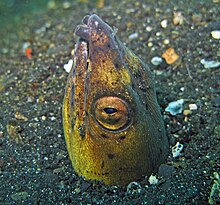| Longfin snake-eel | |
|---|---|
 | |
| Scientific classification | |
| Domain: | Eukaryota |
| Kingdom: | Animalia |
| Phylum: | Chordata |
| Class: | Actinopterygii |
| Order: | Anguilliformes |
| Family: | Ophichthidae |
| Genus: | Pisodonophis |
| Species: | P. cancrivorus |
| Binomial name | |
| Pisodonophis cancrivorus (J. Richardson, 1848) | |
| Synonyms [1] | |
List
Richardson, 1848
(Richardson, 1848)
Richardson, 1848
(Richardson, 1848)
(Richardson, 1848)
Richardson, 1848
(Richardson, 1848)
Liénard, 1842
Richardson, 1848
Cantor, 1849
Cantor, 1849
Bleeker, 1852
Bleeker, 1852
Bleeker, 1853
Macleay, 1881
Fourmanoir, 1961
Fourmanoir, 1961
(non Bleeker, 1853) | |
The longfin snake-eel (Pisodonophis cancrivorus) is an eel in the family Ophichthidae (worm/snake eels). It was described by John Richardson in 1848. It has a Dorsal fin beginning above its pectoral fin with a snake-like upper body which is cylindrical, but compressed only along its extreme tail tip. It also has a tubular nostril in front and a nostril along lower edge of the lip in back. Colors range from grey to black to brown. Large longfin snake-eels have wrinkled skin. [2]




